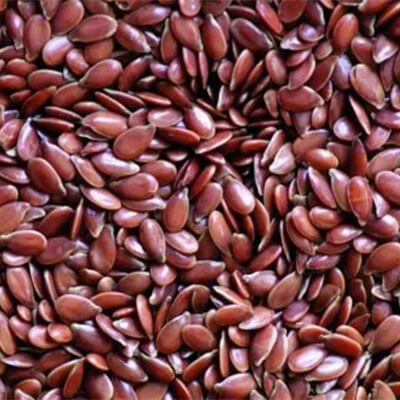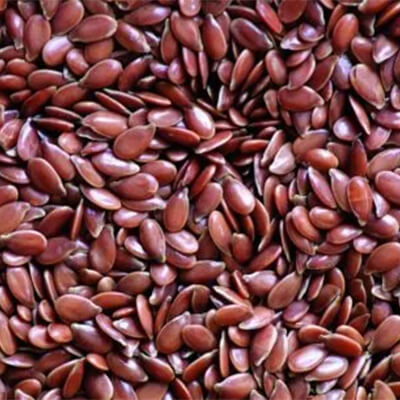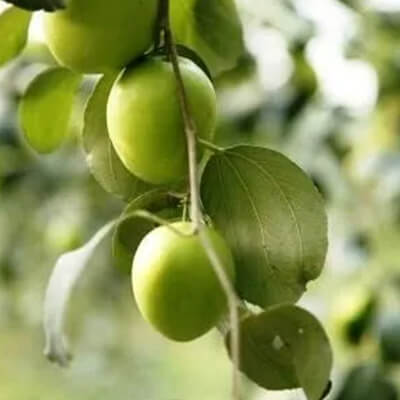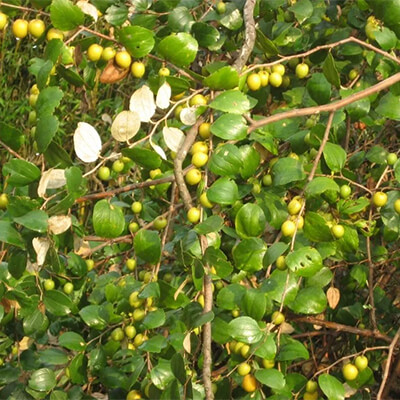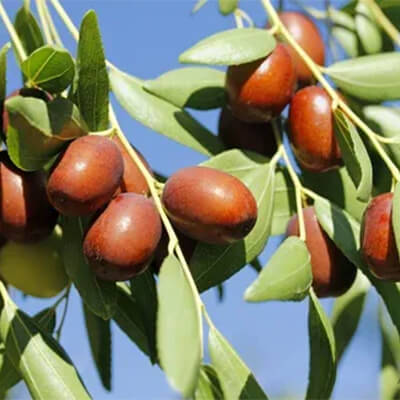On This Page
Flaxseed, Alsi (Linum usitatissimum) – A Functional Food
Introduction
Atasi or Alasi, botanically known as Linum usitatissimum Linn. belongs to the genus Linum in which approximately 230 species are available but only species Atasi (Linum usitatissimum Linn.) has economical importance. Atasi has been grown since at least 5000 BC and is native to West Asia and the Mediterranean. Atasi/ Alasi is considered a functional food because along with health benefits it also serves as a source of nutrition. In Ayurvedic classical literature, Atasi is mentioned in Brihattryi as Rakshoghana Dravya and is well defined with its uses and properties in various Nighantus like Dhanwantri Nighantu, Kaiydeva Nighantu, Bhava Prakasha Nighantu, etc. As per Ayurveda Atasi has Madhura (sweet), Tikata (pungent) Rasa, and Ushana Virya (Hot potency) and it is used to treat various disorders like Vata Rakta (gout), Sotha (inflammation), Parmeha (diabetes), etc. Atasi seed consists of secondary metabolites like Lignans, pinoresinol, Vitamin E, etc due to which it exhibits anti-bacterial, antioxidant, nephron-protective, hepato- protective activities.
Basonym of Atasi – Alasi – Flax seed
अतति सततं गमयति वात व्याधि प्रतिषेधेन |
Atasi (Linum usitatissimum Linn.) is very efficacious in Vata Vyadhi (Vataja disorder).
Synonyms of Atasi – Alasi – Flax seed
- According to morphology
वल्कला- सूत्र मय: काण्ड: |
Atasi has got a fibrous stem.
नील पुष्पी- नीलानि पुष्पाणि सन्त्यस्य: |
The flowers of Atasi are blue.
क्षुमा- क्षौतीति क्षु: नासा तय मीयते पुष्पम अस्या: |
Atasi flowers have shapes like that of a nose.
तैल फला: – बीजं तैल वत |
Atasi seeds are oily.
- According to properties and action
उमा – शक्ति शालिनी |
Atasi is a very potent drug in the case of Vata Vikara.
Regional names of Atasi – Alasi – Flax seed
- The Flax Plant, Flaxseed, Linseed (English)
- Alsi, Teesi, Jawas (Hindi)
- Atasi (Sanskrit)
- Agasi (Kannada)
- Cheruchana Vithu (Malayalam)
- Javas (Marathi)
- Atasi (Telugu)
- Alisikhirai (Tamil)
- Masina (Bengali)
- Kattan (Arabic)
- Jagis (Persian)
- Bazar- ul- Katan, Tukhm- e- Katan, Katan (Unani)
Botanical Name
Linum usitatissimum Linn.
Linum word is derived from the Greek word Linon which means Flax.
Usitatissimum means customary.
Family
Linaceae (Atasi Kula)
Ayurveda reference for Atasi (Linum usitatissimum Linn.)
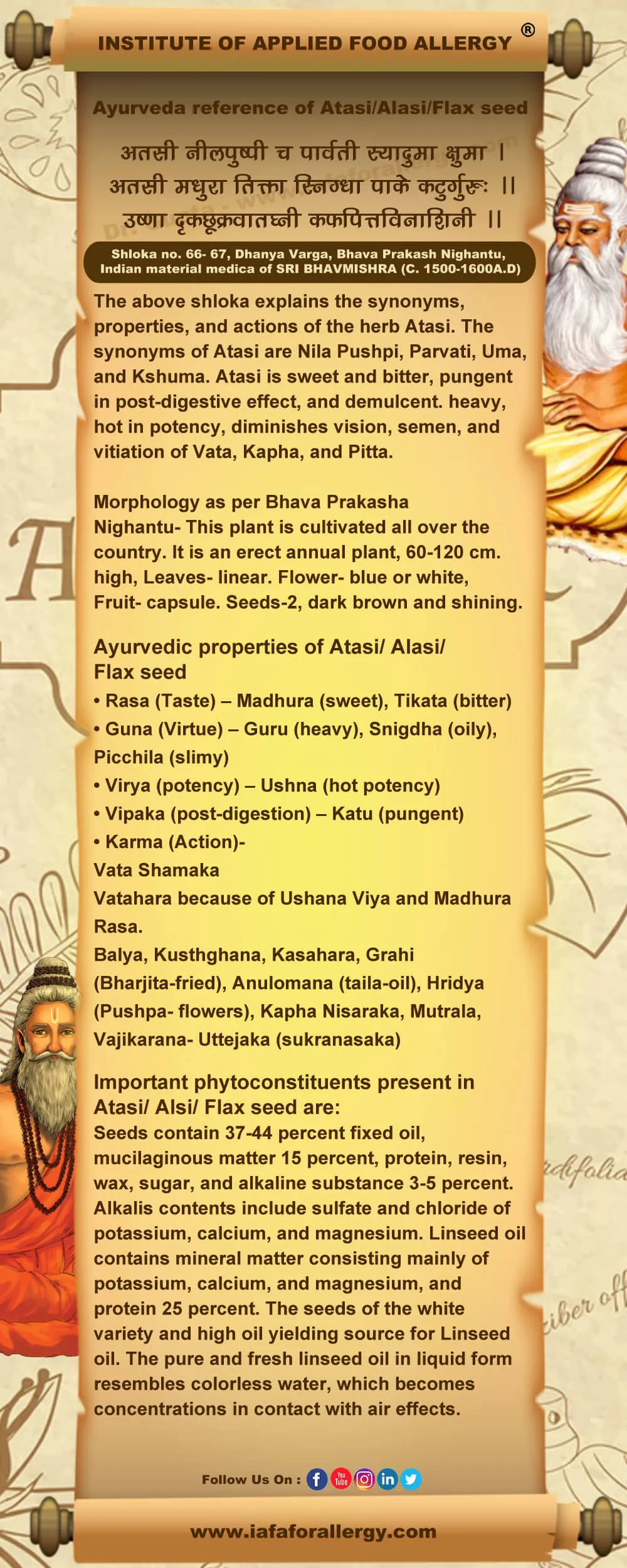
Scientific classification of Atasi – Alasi – Flax seed
| Kingdom | Plantae |
| Class | Dicotyledons |
| Subclass | Polypetalae |
| Series | Disciflorae |
| Order | Geraniales |
| Family | Linaceae |
| Genus | Linum |
| Species | usitatissimum |
Classification of Atasi – Alasi – Flaxseed as per Charaka and Sushruta
- Charaka: Not mentioned in Mahakshaya
- Sushruta: Not mentioned in Gana
Atasi – Alasi – Flax seed’s description in Brihattrayi
| Charaka | Shusruta | Vagbhata (Ashtang Hridya) |
| C. S. Su. 3/ 17 | S. S. Su. 21/ 20 | A. H. Sa. 2/ 25 |
| C. S. Su. 13/ 9 | S. S. Su. 36/ 9 | A. H. Chi. 5/ 79 |
| C. S. Su. 27/ 287 | S. S. Su. 45/ 115, 116 | A. H. Chi. 14/ 87 |
| C. S. Ni. 5/ 7 | S. S. Su. 46/ 49 | A. H. Chi. 17/ 35 |
| C. S. Vi. 7/ 26 | S. S. Chi. 5/ 10 | A. H. Ka. 4/ 56 |
| C. S. Sa. 8/ 59, 76, 93 | S. S. Chi. 8/ 15 | A. H. U. 25/ 37 |
| C. S. Chi. 5/ 140 | S. S. Chi. 11/ 5 | |
| C. S. Chi. 6/ 19 | S. S. Chi. 14/ 7 | |
| C. S. Chi. 8/ 175 | S. S. Chi. 18/ 45 | |
| C. S. Chi. 25/ 50 | S. S. Chi. 31/ 5 | |
| C. S. Chi. Ka. 11/ 10 | S. S. Chi. 32/ 12 | |
| C. S. Si. 4/ 4 | S. S. Chi. 37/ 21 |
Historical background of Atasi – Alasi – Flax seed
It is an annual herb (Rarely shrubby) growing up to half a meter in height and bearing blue flowers. It is used in the treatment of Kustha and Vrana in the Brhattrayee texts. It is mainly used in the external application in the oil form. Acharya P.V. Sharma Ji reports that there are two ecotypes of Atasi viz., Gangetic type and Peninsular type.
External morphology of Linum usitatissimum Linn.
- Habit: Atasi is an annual herb i.e 0.6-1.2 meters in height.
- Stem: Solitary or few, corymbose branched, branches ascending towards the apex.
- Leaves: Leaves of Atasi are up to 3. 8 cm. long, linear-lanceolate, attenuated at both ends, and acute at the apex.
- Flowers: Flowers of Atasi are about 2.5 cm, across, in corymbose panicles. Sepals the 2 outers elliptic, acuminate, with entire membranous margins, the 3 linear broader, acuminate, with ciliate margins, all strongly 3-nerved, the middle nerve alone reaching the apex. Petals blue, slightly crenate. Capsules mucronate, the edge of the dissepiments in the interior glabrous.
- Seeds: The capsule is globose, and splits into 5 capsules, each containing two seeds, The seeds are of a flattened elongated ovoid form with an acute edge, and a slightly oblique point, blunt at one end. They have a brown gloss, polished surfaces which under a lens is seen to be marked with extremely five pits. Seeds are mucilaginous.
Flowering and fruiting time
Winter season
Distribution of Atasi – Alasi – Flax seed
Atasi is cultivated throughout India, up to 600 feet elevation. Atasi is specially cultivated in Uttar Pradesh, Bihar, and West Bengal.
Kinds and varieties of Atasi – Alasi – Flax seed
There are four kinds based on the color of seeds viz.
White (Shweta), yellow (Pita), red (Rakta), and black (Krishna) Atasi.
The useful part of Atasi – Alasi – Flax seed
Seeds, Oil, Flowers.
Important phytoconstituent of Atasi – Alasi – Flax seed
Seeds contain 37-44 percent fixed oil, mucilaginous matter 15 percent, protein, resin, wax, sugar, and alkaline substance 3-5 percent. Alkalis contents include sulfate and chloride of potassium, calcium, and magnesium. Linseed oil contains mineral matter consisting mainly of potassium, calcium, and magnesium, and protein 25 percent. The seeds of the white variety and high oil yielding source for Linseed oil. The pure and fresh linseed oil in liquid form resembles colorless water, which becomes concentrated in contact with air effects.
Recent research on Atasi – Alasi – Flax seed
- A study is conducted to evaluate the effectiveness of Linum usitatissimum in Carpal tunnel syndrome. After the intervention, significant improvement was observed in Boston Carpal Tunnel Questionnaire symptomatic severity and functional status mean differences (P<0.001) in the linseed oil group compared with those in the placebo group. The study confirms that linseed oil is effective in mild and moderate Carpal Tunnel Syndrome. Hashempur MH, Homayouni K, Ashraf A, Salehi A, Taghizadeh M, Heydar, M. “‘ Effect of Linum usitatissimum (Linseed) Oil is mild and moderate Carpal Tunnel Syndrome A randomized double-blind, Placebo-controlled clinical trial. 2014 May 21; 22:43.
- Singh, Bharat & Sharma, Ram. (2020). Linum Species. 604-614. 10.1002/9783527825578.c02-48. This chapter discusses the ethnopharmacological properties, phytochemistry, and culture conditions of the Linum species. Flax fibers of Linum usitatissimum are separated from the shoots of this crop plant and are stronger than cotton fibers. Flaxseed is used in the treatment of cardiac disorders, cancer, arthritis, wounds, abscesses, diabetes, and digestive disorders. The formulated products of flaxseed have gastroprotective effects and possess, inter alia, antibacterial, radioprotective, and nephroprotective properties. The presence of ellagic acid, catechin, chlorogenic acid, gallic acid, kaempferol, umbelliferone, caffeic acid, coumaric acid, epicatechin, and rutin in L. usitatissimum has also been determined by ultra‐performance liquid chromatography in six flaxseed cultivars. The suspension cultures of L. mucronatum were induced in darkness at 25∘C and analyzed for estimation of lignans. During estimation, the 6‐methoxy podophyllotoxin was found as a major compound, and its identity was confirmed by spectral data analysis.
- Antioxidant activity
- Nephro- protective activity
- Hepatoprotective activity
- Immunosuppressive activity
- Analgesic activity
Rasa Panchaka of Atasi – Alasi – Flax seed
| Rasa (Taste) | Madhura (sweet), Tikat (bitter) |
| Guna (Virtue) | Guru (heavy), Snigdha (oily), Picchaa (slimy) |
| Virya (potency) | Ushana (hot potency) |
| Vipaka(post- digestion) | Katu (pungent) |
Dosha Karma of Atasi – Alasi – Flax seed
Vata Shamaka
Vatahara because of Ushana Viya and Madhura Rasa.
Karma (Actions) of Atasi – Alasi – Flax seed
Balya, Kusthghana, Kasahara, Grahi (Bharjita-fried), Anulomana (taila-oil), Hridya (Pushpa- flowers), Kapha Nisaraka, Mutrala, Vajikarana- Uttejaka (sukranasaka)
Prayogarha Vyadhi (Therapeutic indication) of Atasi – Alasi – Flax seed
- Abhyantara Paryog (internal indication): Vibandha, Anaha, Adharagudavarodha, Arsha, Atisara, Grahani, Hridya, Kasa, Shvasa, Mutrakriccha, Bastisotha, Puyameha, Prameha, Kamasaitya, Vatavikara.
- Bahya Paryog (external indication): Vranasotha, Vrana, Vatarakta,Charmaroga- Kustha, Kandu, Agnidagdha.
Aamyik Paryog (Therapeutic uses) of Atasi – Alasi – Flax seed
Vatarakta (Gout): Flax seeds and seeds of Eranda are pounded with milk and applied to the affected part. It relieves pain. In the case of the predominance of Vata, Shatapuspa is added thereto. (Charaka Samhita Chikitsa Sthana. 29/ 140, Ashtanga Hridya Chikitsa Sthana. 22/ 34)
Shotha (Inflammation): Poultice prepared of sesamum, linseed, sour curd, the bolus of parched grain flour, Kustha, yeast, and salt are applied for maturation of inflammation. (Charaka Samhita Chikitsa Sthana. 25/ 51)
Vidriddhi (Abscess): Linseed is included in the group of drugs useful for tearing the abscess. (Charaka Samhita Chikitsa Sthana. 25/ 53- 54)
Vrana (Wounds): In wounds with the predominance of Vata and burning sensation and pain, the paste made of fried linseed and sesame soaked with milk and pounded with the same is applied. (Charaka Samhita Chikitsa Sthana. 25/ 74)
Prameha (Diabetes): Atasi oil is mentioned as useful in Prameha. (Sushruta Samhita Chikitsa Sthana. 31/ 5)
Benefits of Atasi – Alasi – Flax seed
- It is aperient (in piles), aphrodisiac (seeds), astringent (roasted seeds), cardiac (flowers), demulcent, diuretic, emollient, expectorant, and nerine tonic.
- It is useful in burns and scalds (carrion oil-lime water and Alasi oil), colic, eye trouble, gouty and rheumatic trouble (poultice), hemorrhoids, hemorrhages, irritation of the intestine and Genito-urinary passages spasmodic affection of the bowels.
- The fixed oil extracted from the seeds is given orally as a laxative in one- or two-ounce doses twice a day. The oil is used in gravel, stone, pleurisy, and spasmodic affections of the bowels and piles. Carrion oil is well-known which is for medicinal uses also.
- This oil is a mixture of equal parts of the oil and lime water, it is a household remedy for burns, scalds, and skin diseases like eczema, herpes, etc.
- Linseed oil is used for removing spots from the face.
- The oil is administered as an enema in impacted conditions of the rectum and the lower colon.
- The bark and leaves are useful in gonorrhea and the ash of the bark is useful as styptic and vulnerable. The fibers are obtained from the plant, the fibers are recommended to employ as stitching thread (Sivana- Sutra), besides other utility of fine fibers (for textiles), etc. The seeds are mainly medicinally useful and used in various diseases and their oil is administered internally and externally for different ailments.
- The seeds are used in gonorrhea, inflammatory gastrointestinal disorders, irritation of the urinary tract, nephritis, cystitis, colds, cough, sore throat, and pulmonary complaints.
- The linseed tea or infusion of seeds is given orally repeatedly in a small glassful dose as demulcent and emollient for cough and colds. The tea or infusion prepared with linseeds is also mixed with honey or suitable adjuvants.
- As a laxative, the seeds in doses of one to two teaspoonfuls of the seeds are given with water. An infusion made by steeping overnight and an ounce of the powdered seeds in a tumblerful of water is given with lime juice to consumptives.
- The seeds oil is also given in constipation which is prescribed in flatulence, constipation, anal obstruction, and similar intestinal troubles, also in cases of piles for regular and constipation-free motion. The oil is employed as an enema in intestinal and anal obstruction.
- The flowers are useful in heart diseases as they are cardiac tonic. They are also useful as a brain tonic. The poultice of seeds is frequently applied as a household remedy for abscesses, boils, and inflammatory conditions.
- The same application is also made for gouty, rheumatic swellings, and skin diseases. A poultice is commonly applied to carbuncles. In the ailments of deep-seated inflammations such as pneumonia, bronchitis, bronchopneumonia, pleurisy, angina, and other similar chest troubles, the external application of seeds is made and seeds oil is topically applied in nervine, neuralgia, rheumatic pains, skin affections and also debility as the oil is also used as a massage oil.
- Seeds are internally used as an aphrodisiac for exciting sexual desire, but they are considered disavowable to semen. The seeds of Atasi are useful as a galactagogue (StanyaJanana) and emmenagogue.
- The seeds were duly roasted and given in diarrhea and dysentery. The seeds are rubefacient and employed in poultice in various ailments and for reducing the counter-irritant effect of the linseeds poultice the dusting of mustard powder is also sometimes suggested.
- Inhalation of the smoke from burning seeds is useful in cold, head affection, and hysteria. The burnt seeds are useful as styptic and healer, and they are applied externally to wounds and ulcers.
- The seeds meal is used as cataplasms. The oil from seeds is useful in biliousness and backache and it purifies blood, but it may cause loss of appetite. The fumigation of smoke is also considered useful in hysteria and other ailments of cold.
- The mucilage of seeds is good for eye troubles. The seeds are useful in disorders caused by Vata, pitta, and Kapha. The leaves are allaying Vata and used in their ailments.
- The seeds are burnt and their fumigation a smoke (in Dhupana Vidhi) application which is recommended in certain recipes for natal care and infantile care (Prasutika Graha and Bala Raksoghna).
- The seeds and seeds-oil are also used in other ailing conditions and for different purposes (such as paint, dye, varnishes as drying oil, etc. including birds- lime by close cooking).
- The seeds yield oil, the linseed oil which is of non-human use but adulterated and also employed to prepare artificial ghee) is used in veterinary medicine, especially horse care e.g., for constipation in horses; the seeds (cake left after extracting the oil from linseed) is a nutritive cattle feeds (as it is full of protein and also rich in calcium and phosphorus contents).
Matra (Therapeutic administration and dosage) of Atasi – Alasi – Flax seed
- Churna (powder)- 3 to 6 grams
- Pushap Kalka (paste)- 3 to 6 grams
- Taila (oil)- 5- 10 ml

Have A Health Issue?
Consult Online
- Dr. Sahil Gupta (B.A.M.S., M.H.A.)
Ayurvedic Allergy Specialist
CEO & Founder of IAFA®
Classical reference of Atasi – Alasi – Flax seed
Bhava Prakasha Nighantu Dhanya Varga- 66
Synonyms
अतसी नीलपुष्पी च पार्वती स्यादुमा क्षुमा |
Bhava Prakasha Nighantu Dhanya Varga- 66, 67
Properties and action
अतसी मधुरा तिक्ता स्निग्धा पाके कटुर्गुरु: ||
उष्णा दृकछूक्रवातघ्नी कफपित्तविनाशिनी ||
Dhanwantri Nighantu Suvarnadi Varga, 103
रुद्र पत्नी तु मधुरा स्निग्धा च बलकारिका |
कफपित्तकरी चेषत्पित्तहत् कुष्ठवातजित ||
Kaiydeva Nighantu Dhanya Varga- 85, 86
अतसी मधुरा तिक्ता स्निग्धा पाके कटुर्गुरु: |
उष्ण: दृकछूक्रवातघ्नी कफ पित्त प्रकोपनी ||
कासे श्रेष्ठमुमा पत्रं वातरोगे तथा कफे ||
Raja Nighantu Shaalyadi Varga- 118
अतसी मदगन्धा स्यान्मधुरा बलकारिका |
कफवातकरी चेषत् पित्तहत् कुष्ठवातनुत् ||
Kaiydeva Nighantu Aushadi Varga, 84- 86
कासे श्रेष्ठमुमापत्रं वातरोगे तथा कफे |
Raja Nighantu Shaalyadi Varga- 117, 118
अतसी
अतसी पिच्छला देवी मदगन्धा मदोत्कटा |
उमा क्षुमा हैमवती सुनीला नील पुष्पिका ||
अतसीगुणा:
अतसी मदगन्धा स्यान्मधुरा बलकारिका |
कफवातकरी चेषत् पित्तहत् कुष्ठ वातनुत् ||
Raja Nighantu Ksheeradi Varga- 112
अतसीतैलम्
मधुर त्वतसी तैलं पिच्छिलं चानिलापहम् |
मदगन्धि कषायश्च कफ कासापहारकम ||
Dhanwantri Nighantu
वातघ्न मधुरं तेषु क्षोमं तैलं बलासकृत् |
Kaiydeva Nighantu Taila Varga,319, 320
उमा अतसी तैलं
उमा तैलं गुरु स्निग्धं मधुर दीपनं घनम ||
ग्राह्मष्णं कटुकं पाके कफपित्तबलप्रदम् |
त्वग दोष हच्च चक्षुषयं पिछिलाम मलवृद्धिकृत् ||
Bhava Prakasha Nighnatu, Taila Varga, 17- 19
अतसीतैलगुणा:
अतसीतैलम आग्नेयम सिग्धोष्णं कफपितकृत् |
कटु पाक्म चक्षुषयं बल्यं वात हरं गुरु ||
मल क्रीड सत: स्वादु ग्राही त्वग दोष हद घनम |
तैल प्रयोगा:
बस्तौ पाने तथा अभ्यङ्गे नस्ये कर्णस्य पुरणे |
Charaka Samhita Sutra Sthana, 27/ 284
अतसीतैलम्
आतस्यं मधुराम्लं तु विपाक कटुकं तथा |
उष्ण वीर्यं हितं वाते रक्तपित्त प्रकोपनम् |
Sushruta Samhita, Sutra Sthana, 25/ 20
क्षौम -अतसीसूत्रम
सीवयेत सूक्ष्मण सूत्रेण…शणज क्षौम सूत्राभ्यां स्नाय्वा बालेन वा पुन: ।
अतसी गुणा:
Sushruta Samhita
उष्णा अतसी स्वादुरसा अनिलघनी |
पित्तोल्वणा स्यात्कटुका विपाके ||
Ashtanga Hridya
स्निग्धोमा स्वादु तिक्तोष्णा कफ पित्तकरी गुरु: |
दृक शुक्रहत् कटु: पाके तद्वीजं च कुसम्भकम् ||
Charaka Samhita Chikitsa Sthana, 13
पक्व शोथ प्रभेदने
उमा अथ गुग्गुलु: …… |
इत्युक्तो भेषजगण: पक्व शोथ प्रभेदेन |
Charaka Samhita Chikitsa Sthana, 13/ 49
व्रणोपनाहने
स अतसी बीजद अध्य अमला शक्तु पिण्डिका |
शस्ता स्यादु उपनाह्ने |
Charaka Samhita Chikitsa Sthana, 13
वात प्रधान व्रण लेपने
स दाहा वेदना वन्तोये व्रण मारुत उत्तरा; |
तेषां तिलान्युमाञ्च चैव भृष्टान पयसि निर्वृतान ||
तेनैव पयसा पिष्ट्वा कुर्याद लेपनं भिषक |
Sushruta Samhita, Chikitsa Sthana, 13/ 5
प्रमेहे
कुसुम्भ सर्षपातसी…. स्रेहा: प्रमेहेषु |
Sushruta Samhita, Chikitsa Sthana, 29
वाताधिके वात रक्ते
क्षीर पिष्टमुमालेपं…कुर्याच्छूलनिवृत्यर्थ……|
Specific Formulation of Atasi – Alasi – Flax seed
- Atsyaadi Lepa for Vrana Sotha
- Punarnava Aasava for Shotha, Udarroga
- Atasi Upnaha for Sotha
- KolaKulathadi Churna
- Gojiwha Kashayam
- Sharshapadi parlepa
Contraindication and side effects of Atasi – Alasi – Flax seed
Avoid the use of Atasi/ Flaxseed during pregnancy and breastfeeding or use under medical supervision. Atasi oil or flaxseed oil may result in diarrhea in a few patients. Other side effects of Atasi include bloating, constipating, allergic reaction, stomachache, intestinal obstruction, etc.
Suggestive reading regarding Atasi – Alasi – Flax seed
- Singh, Bharat & Sharma, Ram. (2020). Linum Species. 604- 614. 10. 1002/ 9783527825578. c02- 48.
- Tanna, Ila & Pandya, Preeti & Shukla, Vinay & Chandola, Harimohan. (2013). Pharmacognostical and Phytochemical evaluation of Atasi (Linum usitatissimum L.). Indian Journal of Traditional Knowledge. 12. 688-692.
- A review on Atasi (Linum usitatissimum Linn.) as a Nutraceutical “, International Journal of Emerging Technologies and Innovative Research (www.jetir.org | UGC and ISSN Approved), ISSN: 2349-5162, Vol.9, Issue 1, page no. ppd463-d469, January-2022.
- Rashid, Nahida & Ahmad, Hakeem & Rather, Shameem & Dar, Pervaiz. (2018). Alsi (Linum Usitatissimum (Linn.): A potential multifaceted Unani drug.
- Goyal A, Sharma V, Upadhyay N, Gill S, Sihag M. Flax, and flaxseed oil: an ancient medicine & modern functional food. J Food Sci Technol. 2014 Sep; 51 (9): 1633- 53. doi: 10.1007/ s13197- 013- 1247- 9. Epub 2014 Jan 10. PMID: 25190822; PMCID: PMC4152533.
- Youn Young Shim, Bo Gui, Paul G. Arnison, Yong Wang, Martin J.T. Reaney, Flaxseed (Linum usitatissimum L.) bioactive compounds and peptide nomenclature: A review, Trends in Food Science & Technology, Volume 38, Issue 1, 2014, Pages 5-20, ISSN 0924-2244, https://doi.org/ 10.1016/ j.tifs. 2014.03.011. (https://www.sciencedirect.com/science/article/pii/S0924224414000697)
- Bahmanpour S, Kamali M. The Effect of Flax Seed (Linum Usitatissimum) Hydroalcoholic Extract on Brain, Weight, and Plasma Sexual Hormone Levels in Aged and Young Mice. Iran J Med Sci. 2016 May; 41(3 Suppl): S12. PMID: 27840478; PMCID: PMC5103517.
- Dillman, A.C., Brinsmade, J. C.: The effect of spacing on the development of the Flax plant. J. Amer. Soc. Agron. 30, 267– 278 (1938).
- Shafik, Najdat & Abass, Kasim & Jaafar, Shaheen. (2020). Improvement effect of linseed oil on the activity of testes and physiological parameters in mice treated with Bicalutamide. Journal of Advanced Pharmacy Education & Research. 10.
- Akpolat, Meryem & Kanter, Mehmet & Tarladacalisir, Yeter & Aydogdu, Nurettin. (2011). Protective Effect of Flaxseed Oil on Renal Injury in Hyperlipidaemic Rats: The Effect of Flaxseed Oil on Hyperlipidaemia. Phytotherapy research: PTR. 25. 796- 802. 10. 1002/ptr. 3334.
- Saleem, Muhammad H., Shafaqat Ali, Saddam Hussain, Muhammad Kamran, Muhammad S. Chattha, Shoaib Ahmad, Muhammad Aqeel, Muhammad Rizwan, Nada H. Aljarba, Saad Alkahtani, and Mohamed M. Abdel-Daim. 2020. “Flax (Linum usitatissimum L.): A Potential Candidate for Phytoremediation? Biological and Economical Points of View” Plants 9, no. 4: 496. Error! Hyperlink reference not valid..
- FOSTER, R., POONI, H., & MACKAY, I. (1997). Quantitative evaluation of Linum usitatissimum varieties for dual-purpose traits. The Journal of Agricultural Science, 129 (2), 179- 185. doi:10. 1017/ S0021859697004590
References
- Agnivesha, Charaka, Dridhabala. In: Charaka Samhita, ed. Vaidya Jadavaji Trikamji Aacharya., editor. Varanasi: Chaukhamba Sanskrit Sansthan; 2009.
- Sushruta. In: Sushruta Samhita, Sutra Sthana, ed. Vaidya Jadavji Trikamji Acharya., editor. Varanasi: Choukhambha Orientalia; 2005.
- Sushruta. In: Sushruta Samhita, Sutra Sthana, Dalhana Commentary.
- Vagbhata. In: Ashtanga Hrudaya, 9th ed. Anna Moreshwar Kunte, Krishnashastri Navarre, Harishastri, editors. Varanasi: Choukhambha Orientalia; 2005.
- Bhavamishra. In: Bhava Prakasha Nighantu, Dhanya Varga 11th ed. part 2. Brahma Shankara Mishra., editor. Varanasi: Choukhambha Bharati Academy; 2009.
- Bhavprakasha, commentary by Bulusu Sitaram, forwarded by K.C.Chunekar
- Sharma PV, Kaideva Nighantu. Aushadhi Varga, Dhanya Varga Chaukhamba Orientalia, Varanasi; 2006:
- Tripathi I., Raja Nighantu, Shalyadi Varga, Chaukhamba Krishnadas Academy; Varanasi; 2010
- Dhanwamtri Nighantu, Suvaranadi Varga, Chaukhamba Krishnadas Academy; Varanasi.
- Dr. Gyanendra Pandey, Dravyaguna Vigyana, reprint 2012, Chawkhamba Krishnadas Academy
- K. Niteshwar Dravyaguna Vigyan, reprint 2017.
- Dr. J.L.N. Sastry and Dr. B.S. Sastry, Dravyaguna Vigyana, Chaukhambha Orientalia, Varanasi.
- Chakrapanidatta, Chakradatta with the vaidaya Prabha hindi commentary by indra deva tripathi, chaukambha sankrita sansthan, varanasi 2nd Edition, 1994.
Ayurveda is an Indian system of medicine that is popular since ancient times. Dr. Gupta’s IAFA® has been conducting research studies to find out different phytoconstituents of herbs and their action in the body. Such knowledge acquired by our experts is used in the preparation of medicines and providing the treatment facilities safely and effectively. IAFA® is the provider of safe and effective treatment for a wide range of diseases, mainly allergic diseases all based on Ayurveda.

